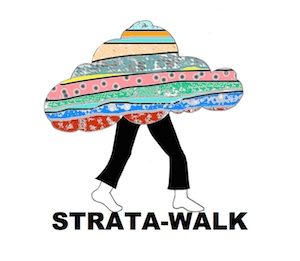The HPU’s Strata-Walk begins with a series of prompts or instructions that are designed to develop the art of noticing as a process of mapping the strata of place. The metaphor of stratigraphy allows the use of many diverse kinds of knowledge, and is inherently interdisciplinary.
Ephemeral strata can be various shades of made-up and true, incidental or mythic, scientific fact or historical fiction. They can leave traces in the landscape, or they can be invisible and in need of explication.
The Strata-Walk urges you to identify different layers of strata as a way of provoking your attention, and can be adapted to any method of mobility.
Ephemeral elements such as smell, sound, weather and time make up strata that are difficult to map but essential to space and place-making. Each of these main kinds of strata can be sub-categorized into smaller strata (“botanizing on the pavement” after Baudelaire and Benjamin). There is no end to the strata.
As participatory workshops, the Strata-Walks function as public pedagogy and relational art, where the emphasis is on the inter-relationships between people and environments, and the creative element does not lie in the making of an object, but an event. The prompts can also be used in groups, or by the solo walker, the commuter, the newcomer to a city, or the tourist.
Our Strata-Walk (Victoria Street/Avenue Version) was a participatory event aimed at highlighting different ways of seeing placenames as vestiges of colonialism, and to propose strategies of decolonizing place. Our Strata-Walk (Mile End Montreal version) was presented in the context of Montreal Monochome IV at the artist-run centre articule, with a specific theme of decolonializing knowledge production.
During the upcoming summer months, HPU will develop further explorations and expand our methodologies. We invite you to participate, beginning with the Strata-Walk.
To map the strata, draw your route with paper and pencil or an electronic device, and attempt to map as many thoughts, sensations, and stories as possible on your walk, using two or more of the following strata-probing-prompts (or make some of your own):
Signed Strata: Identify texts and the systems they belong to (street signs – civic, colonialist; advertising – captialist; graffiti – poetic or interventionist etc.) Why is the street called Victoria? Did it ever have another name? Should it?
Architectural Strata: Identify architectural periods. Note lovely buildings, or intriguing buildings, or decrepit buildings and broken curbs.
Non-human animals Strata: Look for non-human creatures on the street. Pet a cat. Who else lives on the street? Birds? Insects?
Inanimate Strata: Identify plants (native, invasive, useful, ornamental, etc.), note the rocks.
Pre-urban strata: Imagine what was here before, the landscape without the city. Do this without resorting to the trope of “untamed wilderness.”
Electrical Strata: Trace the power lines (where does the electricity come from?).
Shiny Strata: Look for things that are shiny and where the light comes from. Draw or write about them.
Attraction Strata: Notice what is repulsive to you and what attracts you. You can draw or take pictures. Try to use each of your senses for this!
Olfactory Strata: Notice the smells of the street. How can you map sound without using words? If you do use words try synesthesia.
Audio Strata: How does the street sound? What does the street sound? Where does the street sound? Record audio or take notes.
Speculative Strata: Map what the street could be. Revamp it according to your imagination.
Rhythm Strata: What is the rhythm of the day when you move through place? Are you in rush hour or is it slow? What other rhythms can you sense where you are?
Tactile Strata: How does the street feel? Make rubbings, drawings of felt strata.
Storied Strata: Interview strangers (or yourself) on the street and gather stories about the street. What is the street’s history? Any anecdotes?
If in a group, you may wish to designate different prompts to different members, or collectively decide on a few that everyone focuses on (best for smaller groups). You could colour-code your strata and have them on the same map. Or make different maps, or no map! Return your maps to HPU if you please. hamiltonperambulatoryunit@gmail.com
